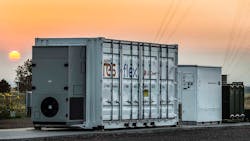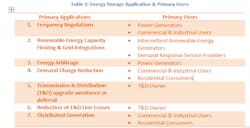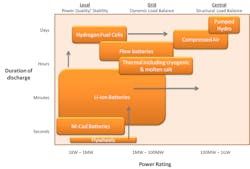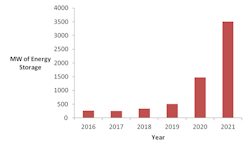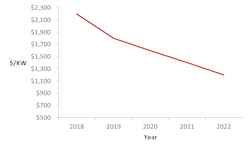Energy Storage: The Vital Connection in the Next Wave of Energy Transition
Exclusive to EnergyTech
What difference can a decade of innovation in battery technology, production systems and market dynamics make?
From powering our phones, laptops, and other electronic devices in 2010 to powering our homes, factories and cars by the turn of the decade; all made possible by more than 80% reduction in cost of battery technologies, particularly, lithium ion batteries over the last 10 years.
This becomes very significant against the backdrop of climate change, especially as the sixth Assessment Report of the Intergovernmental Panel on Climate Change (IPCC) indicated that limiting global warming to 1.5°C requires global emissions to be cut down by 43% by 2030. Energy transition is the most crucial vehicle for GHG emission reduction, and battery energy storage systems will play a vital role in enabling the next phase of global energy transitions across the board – from utility-scale renewable energy production and distributed generation to C&I players, and sustainable transportation.
Application Vs. Technology
Solar and wind facilities use the energy stored in batteries to reduce power fluctuations and increase reliability to deliver power. They store excess energy when demand is low and release it when demand is high, to ensure a steady supply of energy to millions of homes and businesses. Without it, the world would never be able to completely move away from fossil fuel.
In other words, battery storage literally makes it possible to get as closer to Net Zero pursuits as practically as possible, and even achieve it. In general, energy storage systems find seven major applications, as described in Table 1, especially at the utility scale level. Frequency regulation, renewable energy grid integration, energy arbitrage, and end-user demand management are among the leading applications. Battery storage and Uninterrupted Power Supply (UPS) for distributed generation and Virtual Power Plants are fast emerging applications. Aside from utility scale applications, commercially viable energy storage solution for mobility applications is turning out to be a game changer, as evident from the ever increasing adoption of electric vehicles globally.
Source: Reinventing the Energy Value Chain, Jacoby and Gupta (Pennwell, 2021)
Which storage technology is a good-fit for the aforementioned applications relies upon two main factors - power range required and discharge duration. For bulk power management (high-power, high-discharge) applications, the options are normally pumped hydropower storage (PHS), compressed air energy storage, fuel cells, and flow batteries. Another set of emerging technologies for bulk power management include cryogenic energy storage and new variants on gravity-based, thermal, and ocean wave energy storage. Figure 1 offers a precise visual illustration of how each of these energy storage technologies can be applied given their power range and ease of discharge.
Source: Reinventing the Energy Value Chain, Jacoby and Gupta (Pennwell, 2021)
While PHS, as one of the oldest and most conventional means of energy storage, currently representing over 90% of all energy storage in the US, use of battery storage (lithium-ion battery being the most prominent of all) is growing faster than ever because of its low discharge duration and range up to 100 MW. In addition, Li-ion battery storage requires a fraction of capital and time to deploy as compared to PHS systems.
Investment & Capacity Growth
According to Envecologic analysis, global investment in battery storage reached nearly $7 billion in 2021, leading to almost 50-60% annual rise in spending on grid-scale batteries. Aggressive focus on renewables investment and growing popularity of hybrid auctions with storage are driving global growth. In 2020 and 2021, new battery storage capacity addition took a leap of 50% on average, adding a record over 12 GW globally, taking the global aggregate beyond 25 GW mark. While utility scale and C&I related applications drove investments, demand from behind-the-meter storage segment has been lackluster in 2021, mainly due to the COVID-19 impact.
Source: Envecologic analysis of IEA Data
Overall growth has been primarily led by the US and China, both of whom built gigawatt-scale additions, with almost two-thirds of total added capacity being utility-scale installations.
The US battery storage capacity nearly tripled in 2020 to 1.5 GW, and further, more than doubled in the following year to nearly 3.5 GW despite the raging pandemic (Figure 3). Li-ion battery manufacturing capacity also grew to 60 GWh/year in 2021. On the regulatory front, Congress approved a multi-billion dollar Covid-19 relief bill in December 2020, authorizing over $1 billion to support research and commercialization of a range of storage technologies during the course of five years.
Source: Envecologic analysis of IEA & NREL Data
In July 2021, China announced plans to commission nearly 30 GW of energy storage by 2025, equating to almost ten times increase compared to its 2020 capacity. This aggressive growth is mainly driven by renewable energy integration.
Besides China, South Korea and Japan have been actively building energy storage capacity. Korea started off its battery storage journey relatively early to become a leading Asian market until 2020, riding on the government subsidy schemed which were phased out last year, indicating towards a fast maturing and self sustaining market there. Japan made significant progress in behind-the-meter storage installations to reach 300 MW in 2020 already.
In Europe, large portions of storage capacity came from residential installations, led by Germany where behind-the-meter installations nearly doubled in 2020-21. Among APAC countries, India and Australia are emerging energy storage markets, where major capacity addition will take place over the course of next 5-8 years, largely dominated by utility scale commissioning.
Cost
While the total installed cost of various energy storage technologies can vary in a substantial range from $2,000 per kW to over $3,500 kW, that of lithium ion batteries has demonstrated the steepest decline. A 4-hour bulk Li-ion battery installed cost can be as low as $1,200 per kW in 2022 (Figure 4). While economies of scale, battery chemistry and innovation will keep driving the price down at least 10% annually, factors such supply chain disruptions causing material scarcity could possibly be a major deterrent.
Figure 4: 4-Hour bulk Li-ion battery installed cost
While climate change is the biggest threat before the humankind, climate action, including efforts to move away from fossil fuel, offers immense prospects for growth. The fast emerging energy storage market is the best example of such opportunities. As Net Zero commitments start gaining greater momentum, battery storage demand will surge to new heights in the coming decade. In order to ensure unhindered growth, constant innovation is energy storage technologies and battery chemistry must take place.
Alok Raj Gupta is an expert in energy and sustainability strategies focused on economic gains. He is the Founder & CEO of Envecologic, an energy & sustainability think tank, advisory, and training firm, and a Partner at Boston Strategies International. Alok holds a B.A. Honors in Economics from University of Delhi and MS degree in Economics (Resource & Environment Economics) from TERI University, India. He has been practicing as an energy and sustainability economist with a host of global corporations, multilateral agencies, and governments. Alok is considered to be one of Asia's emerging thought leaders, with over a hundred articles, essays and white papers in publication. He has delivered keynote talks and conducted training/workshops at numerous international platforms on addressing the most pressing energy and sustainability challenges of our times.
About the Author
Alok Raj Gupta, Founder and CEO, ENVECOLOGIC
About the author: Alok Gupta is founder of ENVECOLOGIC, a startup to address energy and enivironmental issues using economic logic. Gupta also is chief economist and partner at Boston Strategies International. He is co-author of the book, Reinventing the Energy Value Chain. He holds degrees from TERI School of Advanced Studies, Delhi University and Don Bosco School, New Delhi.
